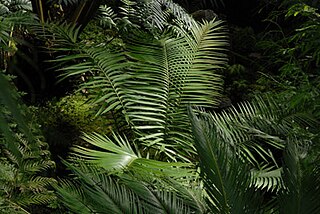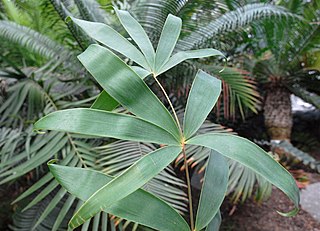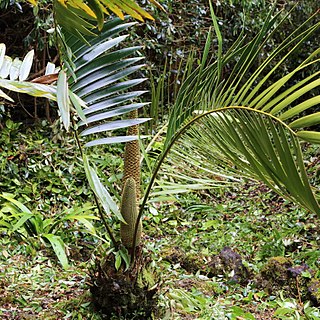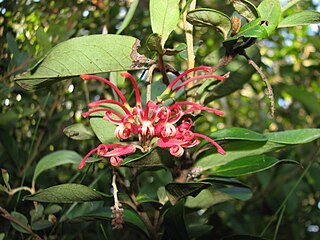
Ceratozamia is a genus of New World cycads in the family Zamiaceae. The genus contains 27 known currently living species and one or two fossil species. Most species are endemic to mountainous areas of Mexico, while few species extend into the mountains of Guatemala, Honduras and Belize. The genus name comes from the Greek ceras, meaning horn, which refers to the paired, spreading horny projections on the male and female sporophylls of all species.
Ceratozamia alvarezii is a species of plant in the family Zamiaceae. It is endemic to Mexico, where it is known only from Chiapas. It is found near Rizo de Oro in the Sierra Madre de Chiapas.
Ceratozamia becerrae is a species of plant in the family Zamiaceae.
Ceratozamia euryphyllidia is a species of plant in the family Zamiaceae. It is found in Guatemala and in the Mexican state of Oaxaca and Veracruz. It is threatened by habitat loss.
Ceratozamia fuscoviridis is a species of plant in the family Zamiaceae. It is endemic to Hidalgo state in Mexico. It is a Critically endangered species, threatened by habitat loss.

Ceratozamia hildae, commonly known as the bamboo cycad, is a species of cycad in the family Zamiaceae that is endemic to Mexico. It is native to the Huasteca Potosina of Querétaro and San Luis Potosí, near the Santa Maria River. C. hildae inhabits deciduous oak woodlands at elevations of 850–1,300 m (2,790–4,270 ft). It is threatened by habitat loss and over-collecting.

Ceratozamia kuesteriana is a species of cycad in the family Zamiaceae that is endemic to the Sierra Madre Oriental of Mexico.

Ceratozamia latifolia is a species of cycad in the family Zamiaceae that is endemic to Querétaro, Hidalgo and San Luis Potosí in Mexico. It inhabits cloud zone oak forests in the Sierra Madre Oriental.
Ceratozamia matudae is a species of plant in the family Zamiaceae. It is native to Mexico, where it occurs in the states of Chiapas and Oaxaca, and its distribution extends into western Guatemala. Though some populations are in protected areas, the species is still affected by habitat loss as forest is cleared for plantations.

Ceratozamia mexicana is a species of plant in the family Zamiaceae.

Ceratozamia microstrobila is a species of plant in the family Zamiaceae.
Ceratozamia mixeorum is a species of plant in the family Zamiaceae. It is endemic to the Sierra Mixe of Oaxaca state in southern Mexico. Its natural habitat is subtropical or tropical moist montane forests.
Ceratozamia morettii is a species of plant in the family Zamiaceae. It is endemic to Mexico, where it is limited to the state of Veracruz north of Jalapa. It grows on steep clay and basalt cliffs in cloud forest habitat.

Ceratozamia norstogii is a species of plant in the family Zamiaceae. It is endemic to the Sierra Madre de Chiapas, in Chiapas and Oaxaca states of southwestern Mexico. It is an Endangered species, threatened by habitat loss.

Ceratozamia robusta is a species of plant in the family Zamiaceae. It is found in Belize, Guatemala, and Mexico. Its natural habitat is subtropical or tropical moist lowland forests. It is threatened by habitat loss.

Ceratozamia sabatoi is a species of plant in the family Zamiaceae. It is endemic to Mexico, where it occurs in the states of Hidalgo and Querétaro. It is known from only two localities, one of which is degraded by agriculture and grazing.
Ceratozamia whitelockiana is a species of plant in the family Zamiaceae. It is endemic to Mexico, where it is known only from Metates and Chiapan in Oaxaca state. Only two subpopulations have been found, with a total population of about 2200 individuals. The habitat is threatened by conversion to plantations using slash-and-burn techniques.

Ceratozamia zaragozae is a species of plant in the family Zamiaceae. It is endemic to the Rio Verde in El Capulín, San Luis Potosí state in northeastern Mexico. It is a Critically endangered species, threatened by habitat loss. It is found southwest of the Rio Verde, in Capulin district.

Grevillea miqueliana, commonly known as oval-leaf grevillea, is a shrub that is endemic to mountainous areas of eastern Victoria in Australia. It grows to between 1.5 and 2.5 metres in height. The species was first formally described by botanist Ferdinand von Mueller, his description published in Transactions of the Philosophical Society of Victoria in 1855. The species epithet honours Dutch botanist Friedrich Anton Wilhelm Miquel (1811-1871).
Ceratozamia mirandae is a species of cycad in the family Zamiaceae endemic to Chiapas and Oaxaca, Mexico. It is found on the slopes of the Sierra Madre de Chiapas and Sierra de Niltepec, near La Tigria.











